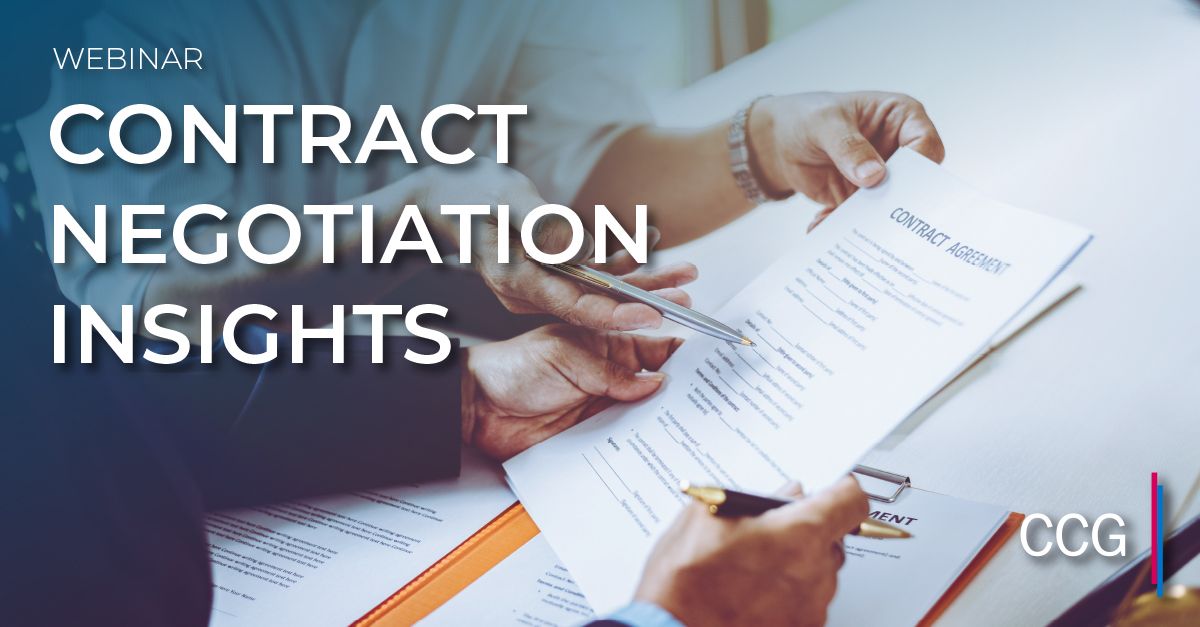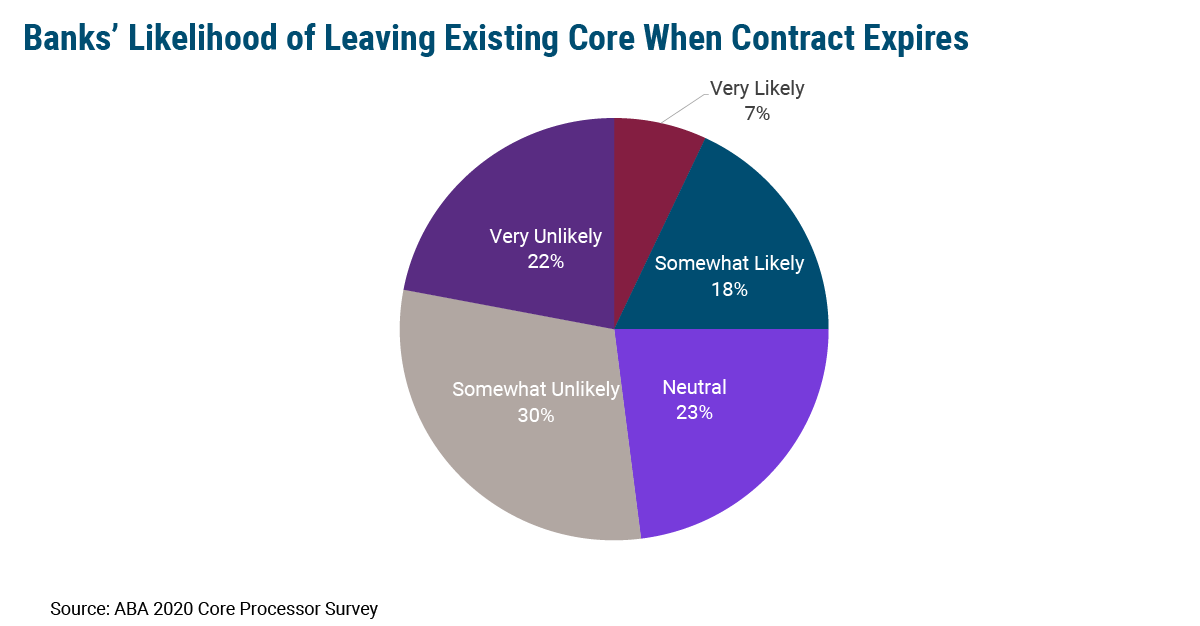Available On Demand – 33 minutes
Is your vendor contract getting ready to expire? Do you need to revisit the terms based on the latest changes to your business environment? Are you looking for more or different products? Replacing older products and upgrading to newer technology? Maybe you are going into a new line of business. Are you paying for products you are not using? Do you feel trapped in mediocre service?
CCG’s Pat Valentino explores contract negotiation and how to better understand an agreement with your vendor and use it to better manage your vendor relationship in the upcoming webinar. Tune in to find out what you need to consider when it is time to renew your contract.
Patricia Valentino [00:00:10] Welcome all. Thanks for joining us today. Sam and I look forward to sharing our insights with you on this pretty exciting topic. But before we dive in, I’d like to discuss a few housekeeping tips. As always, you’ll see a variety of buttons at the bottom of your screen, one in the center with a picture of our bios. If you click on that, you will see a full background on both Sam and me. And you can connect via email with us and the rest of the CCG team directly. To the right of that, you’ll have the CCG logo. This is your go to resource for all things regarding CCG. We’ve published articles, linked to future webcasts and webinars and more information from the blog and other things we’ve been doing. So you can find it all right there. To the left is your Q&A button. Throughout the course of the webinar, if you have questions, please go ahead and enter them. We’ll do our best to answer. But if we don’t get to your question today, don’t worry. We’ll respond to you by the end of the day. All questions are important and there is no wrong question. Feel free to leave any comments. We’d love to hear your feedback. Good, bad, things we could do different. Always open for that. We’ll try to keep this to the point. Topical, relevant. Want to make sure that we make a good use of your time since we know that everybody’s got a lot to do. So today we thought we’d take you outside and do a bit of climbing. For the past hundred and twenty days or so, we’ve all been in a self-imposed quarantine or social distancing. I’ve really found myself wanting to relate the process of contract negotiations to some sort of outside event. So as we walk through, should I say climb through our presentation, we’ll hit these main topics that will help frame up the process. So, Sam, would you like to tell them what they can expect to take away from the climb today?
Samitha Moodley [00:02:06] Sure Pat. Thank you. We have geared this climb to provide you with three key takeaways that we believe will help you. Firstly, look at the different components and understand your contract. Secondly, allow you to figure out what’s more important to your organization in this contract and lastly to build a plan to help you achieve those goals.
Patricia Valentino [00:02:28] Thanks, Sam. So let’s begin our story. Why would you even want to take this sort of climb? You might ask yourself what’s in it for me or my financial institution? What’s in it for the others going on the journey with me? The vendors, my coworkers, my executives. How do I convince others to even join me on this? And why would anyone want to open up a long term contract? Well, I’ll tell you, because there are changes to the business since the contract was made and things are always evolving. So knowing and looking about your contract and really taking the time to look at it is important. Banks make acquisitions. They change strategic direction. Vendors retire products. They merge. A negotiation is really a business relationship for both sides. And it’s not only about squeezing out the best terms for each party at the time, but how that contract works long term for each party. We’ve had contracts with two and a half years still remaining and the clients come to us to talk about how they might open this up and renegotiate maybe rate reductions, performance exits and stronger support for their product and implementation. So really, there’s no reason not to take a look at your contract. Now, I know what you’re saying. Contracts should be one sided because one party, the vendor, has more or better information surrounding all the contract points. They do it all the time. But if you know what you have in your contract, it might not be so one sided. The lack of trust we see with our clients and their vendors is sometimes exacerbated by really not understanding the leverage you, the client, has in your contract. Even if you don’t think you have any. It only stays one sided if you don’t actively engage by using your contract. So let’s start. Before you go on any journey you need to determine what supplies, scales, tools you have today that’s going to help you going forward. This helps you assess what you need and where you ultimately want to go. So, Sam, why don’t you start us off on some of these things.
Samitha Moodley [00:04:47] Sure Pat. In a contract negotiation, one of the most important parts to understand is the terms of the agreement. The term refers to the duration or the period of the contract that is valid. So does a longer term necessarily mean better pricing? Your vendor might have you think that, but is really true? Does this tie you into products that are not really new or innovative? The next thing is ongoing support. This relates to the support that the bank receives from the vendor throughout the duration of the contract. So do you have adequate support on a daily basis? Think about projects. Do you have many projects that seem to fall apart because the vendor is so siloed? How strong is your SLA? Do you manage them or wait until you’re so frustrated that you just lose trust in the vendor? Mergers and acquisitions? When a financial institution establishes a business strategy, it’s important to check that the contract and the business strategy align. This means that if your strategy is to acquire another financial institution, your contract could be worded in such a way that you reap the best benefits from it. For example, pay less convergent fees. Or if your goal is to be sold, how do you restrict paying those early termination fees? New product pricing. You need to understand what is in your contract and what is stated regarding purchasing new products. For example, there might be a clause built into your current contract that provides you with discounts if you purchase new products or you might be stuck with products that don’t really work or have become obsolete. How do you avoid this? And lastly, most of the contracts that Pat and I look at have a price adjusted. Which is the CPI or an ECI, which is your consumer price index or employment cost index. So is that something you manage back into your overall business costs? Do you feel like you’re getting service or products that continue to improve? Think about it like this. It’s like tipping for a service. Did the person in this example, the vendor, provide you with exceptional product innovation or service or was it just average? So Pat, what are the areas do you think they should look at their current contract?
Patricia Valentino [00:07:17] Thanks, Sam. Those are all great ideas and insights into what they should be looking at, you know, continuing on this slide like limitation of liability. Have you had a financial or loss exposure with your vendor? Did you understand the amount of liability you’d be responsible for and why? Is your liability based on product or overall payment to the vendor? How does that work for you? And is that an area you need to really dig into? Support for your innovation. Does your contract allow you to move quickly from a fast fail or a success without having long term expense? What if you put a product in didn’t really live up to the demo? What happens when roadmaps are missed? Promises are made. And you’re stuck without any ability to make those promises come to fruition? How about your ability to use third party products? Does your contract make it costly for you to use those products outside the vendor’s products suite? Do have the ability to use the product. But you don’t get any support from the vendors, so you really can’t get the data you need to support your third party. Risk. Big word. Well, you can’t outsource the risk of data processing to a vendor. You can manage that risk. What areas do you hold your vendor accountable to with regard for keeping the software compliant, keeping your private data private? And have you given them rights to your data without even knowing it? Those are areas you need to take a look at. Product and contract interdependencies. Now, this one’s a big one. When you start to look at long term contracts, how are all your amendments and schedules interrelated? Do you have rights in the master agreement that today a vendor might not give you that you want to protect? How do you make sure you protect those but still gain the newest protection? And what about your schedules and how they override your master agreement? Have you knowingly given away rights in your master by letting the schedule override it? Most the problems we see when Sam and I are working on contracts have two areas on the financial institutions side. Hate to tell you, but we have a lot of folks we work with that haven’t read all of their contract and amendments. I’m saying they’re not the most lively thing to read. But you do need to know what’s in there. And they don’t know where all the amendments or all the schedules are. So they may have had over time signings of different products and different amendments and schedules and haven’t kept it all in one area. They also don’t really trust the vendor to provide transparency. So everything they read is with a critical eye towards a gotcha. They don’t negotiate the prior contract. So they don’t understand what’s in it. And the spirit of that prior contract, they don’t manage the vendor to the terms in the current contract, understanding where their guardrails are to be able to make sure they’ve got performance where they need it. And I know you might be surprised at this one, but many don’t know the actual expiration date of the contract and the various products and the notice terms. So where Sam talked about terms, even renewal terms and notice terms are really important. On the vendor side, we see that mostly on a vendor contract side, while the account manager and client partner at times can be very knowledgeable about the contract. It really becomes the legal and the pricing departments who truly understand all the nuances of the particular contract. Vendors have changed formats and versions over time. And within the same financial institution, we can see multiple versions of a similar contract that lay over each other. Usually, there’s a lot more legalese than plain language, which again, back to reading the contract makes it a little hard and best, you know, for those insomniacs who need to be able to be put to sleep. So reading the contract, even if it’s not in plain language, is important. And again, there are changing price metrics at each renewal. So even within the same product, the way the vendor will price the product can change period over a period, making comparisons very difficult. So the ability to know what you were paying before and what you’re paying in the future and where those discounts will really show up becomes a challenge. We had a client with a 15 year relationship with multiple contract amendments, schedules and changes. And the team that was tasked to work on that negotiation had not had the time to read all the contracts or the amendments before they even began negotiating. We step that process back, helped everybody review so we could actually know what we were negotiating and what we had before we even started. So, Sam, do you have advice for anyone who wants to get out there and handle their contracts.
Samitha Moodley [00:12:26] Sure Pat. Before you start to climb, you need to know what you have and what you need. So do you have all your contract documents? How do you know that you have them all? It’s important to recognize what documents you have and how those documents affect each other. You need to be able to identify what rights and obligations you have in your general terms section of the master service agreements and compare them to the rights and obligations to different schedules with each product. Not to mention if there’s any amendments that you might have made along the way. Once you understand that, then you need to make a list and reconcile all the key rights for each right and understand which document takes preference. If there is a conflict between the two, why should you do this, you may ask. Without knowing what you have, how would you know what you need to be successful?
Patricia Valentino [00:13:21] That’s absolutely right, Sam. Understanding what you have is the key first step to making sure you get off on the right foot. So now we’ve gone through the analysis and we’re going to look at how do we define our goals as we work through this? We’re ready for our climb, but now we need to know where we want to go. Understanding the strategic direction of your organization can help build a stronger contract that allows the vendors to support your goals, not inhibit them. Like Sam said, if your plan calls for growth by acquisition, crafting language to help promote that goal versus stifle, it is hugely important. Conversely, pure organizations in the survivalist mode crafting language that helps you maintain or improve status quo might help you be more attractive to potential suitors. If your organization’s all about efficiency, proving margins, shareholder value, then focusing on pricing and delivery costs might be your primary drivers in a negotiation. If you want to enhance your business strategies with product leverage, develop more literacy on your technology to better advance yourself in the market by the use of what you have. Maybe more training and operational reviews are important to make sure you’re utilizing the system in the best possible way. Knowing your bank’s strategic direction will help you build a contract that meets your needs on the journey. But is that all? Once you know what your organization needs, then you need to understand what your goal for the contract tone is going to be. What do I mean when I say that? Well, most of us look at our contracts, and I would say you would bet they’re more transactional. Built to make sure that your vendor doesn’t abuse their power against you. Be one sided. It helps you avoid price raising. It helps you avoid them changing their delivery times and delivery services at any point in time. It helps you to contract in your belief for maybe some future events. And it might allow your various vendors to work autonomously because there is no relationship built between the vendors. It’s just that particular contract, a relational contract is really built on more mutual goals and governments to keep your interests align. What I mean by that? Well, it has mechanisms that allow for you to continually align expectations as your business changes, as their business changes. It helps you update the reference points. Service levels, delivery times, those kinds of things. It helps you define how to address unanticipated events. It doesn’t help you try to define those unanticipated events, because I daresay nobody would have defined a 100 year pandemic in their contract. It allows for your various vendors to rely on each other for interoperability. For example, you might have a different digital provider or a different payments provider than your core provider. And a relational contract eases how those third parties work. We look at a traditional transaction, a relational contract, or do you want to try and build a blended strategy? Sometimes you might not always get your wish, but you need to kind of look for what you’re trying to assess. I have an example where we did have a financial institution who really wanted to build a relational contract with their vendor. They wanted to be able to meet their client’s needs. And by virtue, want the vendor to meet service needs to them. But the vendor admitted they weren’t able to meet the requirements that that financial institution wanted. So the negotiation changed back to transactional. We determined that if you can’t give us the relationship we’re looking for, then our pricing needs to be lower than what that premium pricing would be. So there are various ways to look at this. Sam, what else should they look at when their defining contract goals?
Samitha Moodley [00:17:42] So just like on a climb or a day trip, you need to ask yourself what else you might accomplish as long as you make the effort. So some of those things to consider would be, are you having service issues? Is your bill too complicated or are they too many pricing components or do you need new products? Do you have old products that you’re not using? Do you need a technology refresh? Pat, what else might we need to consider?
Patricia Valentino [00:18:12] Well, how about if you need a different vendor? How would you know if you needed a different vendor? How would you go about comparing vendors? Do you need a full evaluation or do you simply want to see competitively what’s out there to help your negotiation? What’s the difference? Well, I’ll let you know. So stay tuned for future webinars, because that’s an area we’re going to go over with you. But those are areas you should consider. Remember these items? Now that you understand what you have and what your goal is, now you can begin a key part of your journey to define success. While you’re on a major climb or even a minor climb up the hill, you have to determine what success on that climb will be for you and how will you know if you’ve succeeded it. Is your success to reach the top at all costs? What about your partners on the climb? Do they agree? If you haven’t determined what’s most important to defining success and you just really want it all, then you’re likely setting yourself up for disappointment. And this is true both for the financial institution and the vendor. Remember when we began, we talked about this being a business relationship. A negotiation is a business relationship. So you approach the contract that gives you the best pricing in terms that you want, or do you try to build and legislate a way to protect yourself from one sided vendor agreements, making sure you don’t miss anything. Or do you make the vendor pay for lack of trust? Many of these negotiation styles or tactics will likely result in long term disappointment for everybody. So after this, are you asking yourself why negotiate at all? Well, I’ll tell you why. I think vendors are now moving to changes in their contract processing to address frustrations they’re seeing in the market. So we’ve seen announcements from vendors that indicate they’re bundling, they’re removing term, they’re ending term fees. So I ask you, would you change your vendor for a simpler contract? Maybe. But first, you need to understand the risk and reward of those changes and how that fit in your plan. But I might say some of you might, given the right motivators. Some vendors will continue to provide an old style and maybe some of you would say it’s difficult to understand contract- impact billing, how you use products, your overall understanding and management of the contract. But I ask you, would you stay with that vendor if they lowered your price 35 percent, 40, 50 percent? If your goal is to be more efficient, you might say it’s worth it. So now I come back to you and say, why wouldn’t you negotiate? There are so many areas for you to look at. So now, before we actually start the final approach to your most difficult part of the climb, we need to figure out leverage or your why. What do you have on your side that will allow you to overcome some obstacles? But first, let’s go to the easy side. What are the vendors willing to negotiate? I use the word willing very emphatically, actually, willingly. Maybe not so much. But if you have something they value or could be valuable for them, they’ll always listen to you. So having that dialog is very important. Mainly, we see clients go into these negotiations trying to leverage only two main tools with the vendor price and term. But I challenge you to revisit something. Does this look familiar? I think you need to prioritize what’s most valuable to you. So once you define success, you need to prioritize that from a value position and then begin to identify your leverage. If you have priorities, then you’re able to work with your vendor towards successes that matter to you. Leverage what you have. I’m going to take you on a little detour right now and give you a climbing example of leverage. Anybody seen the movie Free Solo? It’s a National Geographic film that’s now playing on Disney Plus. And if any of you’ve been in quarantine, you have obviously with children subscribe to Disney plus or your Disney fans, one or the other. Anyway, it’s about Alex Honnold. He free climbs up the face of El Cap or El Capitan for those of you who are not near Yosemite. And a free climb is done without ropes or support of any kind. It’s you, your hands and your feet. Alex’s leverage was not his hand strength, which is phenomenal if you watch the movie or his physical abilities, but it was a lack of fear as we mortals might perceive it. He found this out based on a C.T. scan of his brain, that he reacted completely differently to fear than most people. It was one of his key leverages that he researched, investigated and found to be his advantage. So I recommend this movie to anyone as it tells a fascinating story about preparation, goals and success. And it makes contract negotiation look easy. So now back to our story. I think it’s about your organization’s leverage in contracts. There’s both positive and negative leverage and both are used in negotiations. Positive leverage is your organization. Is it growing? Does it have organic or inorganic growth? Are you adding new products that you could move to the vendor? We talked about maybe all your products aren’t with a single vendor, but maybe there’s an advantage to doing that that you hadn’t considered before. And it is some leverage. Are you an influence in your market? Do other institutions follow you? And you have that ability to show the vendor look, I’m influential and others will come if I endorse you. Are you a long term client? Have you been there and can give lots of positive feedback with this vendor and actually have value to the vendor with that long term relationship? Do you have a large spend with the vendor? It’s important. Vendors don’t like losing money in any way, especially large spend clients. Let’s go to the negative side. Some of the leverage you might have from a negative standpoint is you’ve had repeated service issues. They are quite up to SLA or breach of contract, but they really are impactful and the vendor really wants to address those or help address those with you versus losing a client. You always have the ability to change vendors. Why do I call this negative leverage? Because no one feels good about changing vendors. They feel like there’s going to be an impact to the customer. There’s going to be disruption to the organization. Well, key here is a core change doesn’t impact your customers as much as it impacts you internally as the bank. So you do have that ability to change and you should not be afraid of that. That is something that is very powerful in a negotiation and lacking reliance on a sole vendor can also be that negative leverage. You don’t have to rely on a sole vendor. You can split it out. You can use third parties. We have an example of one of our clients who was having major, major product problems with less than six months from term data on the client contract, and they have given notice. But we were actually able to use this in both a positive and negative way in the sense that we were going to move the service and take that product away. They would be left with some. But if they wanted to retain it all, the whole organization of the vendor had to come together, not just the particular silo. And the idea that somehow if you’re close to termination, the vendor will stop the service. That’s a myth. They’re not going to stop the service. So remember, when you give notice of not renewal, it doesn’t mean you’re not going to keep the service. It just means you’re not renewing the contract the way it exists today. Now, we’re actually going to get to the steepest part of the climb and where the most risk in any of this is the actual negotiation. So I like to always talk about negotiations in beginning with the end in mind. What is your minimum success? You might hear me say that go well I’m going to go in this for the minimum. I understand. However, if you define what’s your minimum success, everything else is gravy on the top. And so you have a leverage in things to negotiate with. If you know where your minimum or show stopper part of success is. Build the plan. How are you going to work through this process? What is going to be your process for negotiating this contract? You’re going to have multiple meetings? You’re going to do it through email? Who’s going to be involved? Where are the key decision points? And identify the key components that you require and prioritize them. Again, back to that minimum success. Defined this succinctly as possible for the desired goal of what they call the ask. Be really clear on what’s important to you. And be prepared. Learn as much as you can about the products and services you’re trying to contract so you can avoid pitfalls. Learn and listen as much to the vendor and your peers. Listen, but not always act the way your peers act. But listen to what’s happening there and know the triggers for all your decision makers and manage them. Most cases when Sam and I are working on contracts, there is a leader from the financial institution behind the scenes. There is a majority of people who have input or say decision makers, you need to be able to manage them because you could get all the way through a contract process. And one of your key decision makers comes up at the last minute with, oh, why didn’t she put this in the contract? Also, don’t try to contract for every conceivable variable. This is really where we get hung up because we can’t contract for every conceivable variable in a contract. We can contract for what we do if something comes up, but not for the particular situation. Like I said, I don’t know how many of you have hundred year pandemics in your agreement. Try to build language to address how you handle these unforeseen external factors or how you address repeated quality problems, or even how you would address lack of trust, which is a pretty big item to have to look at. And again, one of my final or favorites, don’t negotiate against yourself when you do this, you’re simply allowing the other party to take control of the negotiation. Sit back. Have your asks. Wait for responses and talk through your various parts of your negotiation. So, Sam, are there other points you’d like to add?
Samitha Moodley [00:30:08] Yes, Pat. So you need to think about: Can you make this climb yourself or do you need help? Pat and I often see financial institutions prepare by asking peer banks for all the concessions that they receive in negotiations. Then the financial institution tries to gain those benefits by asking for them themselves. So in essence, they ask for everything and actually see nothing they actually need. Do you have a full understanding of the market industry? What changes the vendors making and products and pricing? Do you know if the vendor is moving towards being a payment company or a solution company? And how innovative is your current vendor compared to others? Pat, what else might I have missed?
Patricia Valentino [00:30:58] Thanks, Sam. I think as I am talking and hearing, I think I would add are you emotionally attached to the outcome of this negotiation? When you buy a house, when you buy a car, those are big purchases and they’re very emotional and you have a desired outcome. That sometimes when you’re in the negotiation, it feels personal. Personally, I will say, and I’m sure Sam’s the same way we negotiate things all day long for our business profession. But I look for outside help when I’m negotiating big purchase items, especially when I know I’m emotionally attached. So really, look at your emotional attachment to the outcome and see if during the process it’s influencing you in your direction. And remember, not one size fits all. So every single one of these contracts is different, even though they look the same sometimes. So why Catalyst Consulting? We believe that based on the fun you have with Sam and I today our stories, positive outlooks that engaging us to assist in contract negotiation is always a step in the right direction. But regardless of who you engage or how you go about it, remember, a third party can be the face of those hard conversations and difficult negotiations. Sam and I look at these things all day long and really have a bird’s eye view from the top of the climb. So that’s pretty much what we have to share with you today. We thank you again for taking the climb with us. We encourage you to reach out to any of us with questions, comments. We’ll take back the questions we weren’t able to get through today. You can contact us based on the information at the bottom of the screen. And we look forward to talking to you again in future webcasts. Thank you.
[/restrict]Is It Finally Time for Open Banking’s Debut in America?
Digital Strategy Practice Info
Retaining Role in Payments Means Harder Fight for Small Banks
Over the COVID Horizon, Mobile Banking Demands Strategic Clarity
 Pat Valentino is a Principal & Chief Relationship Officer and brings over 30 years of financial services and technology experience in financial services ranging from multinational, community to credit unions. Specialties include strategic planning, technology systems, evaluations, contracts, omni-channel, digital experience and regulatory compliance.
Pat Valentino is a Principal & Chief Relationship Officer and brings over 30 years of financial services and technology experience in financial services ranging from multinational, community to credit unions. Specialties include strategic planning, technology systems, evaluations, contracts, omni-channel, digital experience and regulatory compliance.
Pat has truly done it all in financial services, a banker, an examiner and successful executive in a Fortune 500 company.
 Samitha Moodley is a CCG Catalyst Consultant. She specializes in contract negotiations to ensure that banks receive the necessary service and products from their vendors. Her legal background as an attorney enables her to understand the intricate workings of contracts and how to keep her clients at the forefront of any negotiation. Samitha formerly worked for Union Bank and Chase Bank where she served in the legal processing department.
Samitha Moodley is a CCG Catalyst Consultant. She specializes in contract negotiations to ensure that banks receive the necessary service and products from their vendors. Her legal background as an attorney enables her to understand the intricate workings of contracts and how to keep her clients at the forefront of any negotiation. Samitha formerly worked for Union Bank and Chase Bank where she served in the legal processing department.







